Shipping
 This
is a floating ice pier. It is almost impossible to get a normally
constructed pier to survive the constant crushing ice that occurs
during the winter. The American engineers designed a floating
pier made from ice. Every 5 to 7 years they build a new pier by
going out on the new sea ice during winter and making a small
wall around the area of ice they want to use. Then they gradually
fill this enclosed area with fresh water from the RO plant (reverse
osmosis plant that filters the salt out of sea water ). They
build it layer by layer and put steel reinforcing (like you do
with concrete) in between each layer.
This
is a floating ice pier. It is almost impossible to get a normally
constructed pier to survive the constant crushing ice that occurs
during the winter. The American engineers designed a floating
pier made from ice. Every 5 to 7 years they build a new pier by
going out on the new sea ice during winter and making a small
wall around the area of ice they want to use. Then they gradually
fill this enclosed area with fresh water from the RO plant (reverse
osmosis plant that filters the salt out of sea water ). They
build it layer by layer and put steel reinforcing (like you do
with concrete) in between each layer.
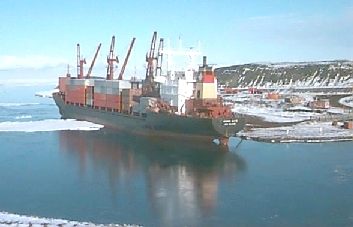 The ice/snow wall around the pier is constantly
built up to keep the water in and as the weight of the ice builds
up it slowly lowers into the water (but never goes below it. The
reason for using fresh water is because fresh water floats on top
of salt water (i.e. it has greater buoyancy) and it also takes a
higher temperature to melt it so that during the summer it doesn't
just melt away as quickly as the sea ice which has a very high
salt content. They make the pier about forty feet deep and then
put soil on top of it, to stop the sun from melting it during the
summer. It also stops it from being too slippery to drive on. The
pier is also held to the shore with large wire ropes, so that it
can rise and fall with the tide. Every year it is inspected by
divers for erosion due to melting and ships rubbing against it.
Often cracks will appear and these are fixed by putting fresh
water into them and letting it freeze. When the pier gets too
damaged to repair, they cut the ropes, and then drag it out to
sea so it can melt away into nothing just like any other iceberg.
The ice/snow wall around the pier is constantly
built up to keep the water in and as the weight of the ice builds
up it slowly lowers into the water (but never goes below it. The
reason for using fresh water is because fresh water floats on top
of salt water (i.e. it has greater buoyancy) and it also takes a
higher temperature to melt it so that during the summer it doesn't
just melt away as quickly as the sea ice which has a very high
salt content. They make the pier about forty feet deep and then
put soil on top of it, to stop the sun from melting it during the
summer. It also stops it from being too slippery to drive on. The
pier is also held to the shore with large wire ropes, so that it
can rise and fall with the tide. Every year it is inspected by
divers for erosion due to melting and ships rubbing against it.
Often cracks will appear and these are fixed by putting fresh
water into them and letting it freeze. When the pier gets too
damaged to repair, they cut the ropes, and then drag it out to
sea so it can melt away into nothing just like any other iceberg.
This is a picture of the Green Wave. It's
the cargo ship that carries all the large supplies down to us. It
has cargo from both America and New Zealand and makes one trip a
year to see us.
Just to divert from the subject of ships
for a while as I want to explain a bit more about the bay.
The ice pier for the McMurdo base is
built at Winter Quarters Bay, just beside Discovery Hut, which
you will see in the background of some of the pictures. Winter
Quarters Bay was, at one time, renowned for being one of the most
polluted bays in the world. Today, I don't think you would find
that the case. In the old days, things being as they were, nobody
cared about what they did with their rubbish. This goes for a lot
of the civilized world, not just Antarctic. So they used winter
quarters bay as a dumping ground, among other places. Even though
they have been extremely industrious in there efforts to clean up
the place over recent years, you will still see old equipment,
vehicles, etc. under the water if you look hard enough. Im told
there are even old drums filled with toxic chemicals which litter
the sea floor but this rumor is unsubstantiated and it would take
an ecological disaster of one of these drums bursting before any
proof could be obtained. This dumping no longer happens. In fact
the Americans have made huge efforts to clean up their act when
it comes to the disposal of rubbish. I would like to think that
many of the other international bases around the Antarctic could
say the same, but from what I have heard from other people, I
know this is not true. I'm not saying that every base is
polluting the environment, but I have heard stories of a few
countries that do not seem to care about the pristine environment
they live in. A friend of mine once said that "if you don't
want to pollute Antarctica then don't come down here". That's
true, but there are ways to limit the pollution we cause to our
environments, where ever we may be !. It's good to see that the
American and NZ programs are now doing their best to leave the
least possible impact on the environment. Enough said I think. (
I might do a section on pollution and environmental impact later.)
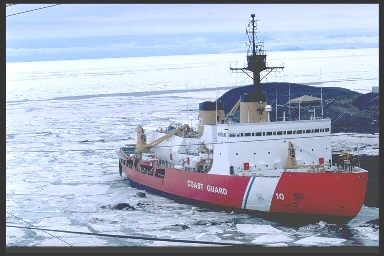
The American Coast Guard Ice Breaker.
The ship we had down this year was called
the Polar Star. During other years it has been her sister ship (the
Polar Sea) which has been the one to come down. These ships break
up the ice and allow other ships to come into port. They hang
around for a while and make sure that the ice doesn't come in and
trap any of the boats that have to dock.
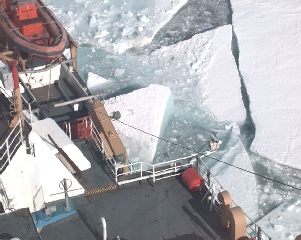
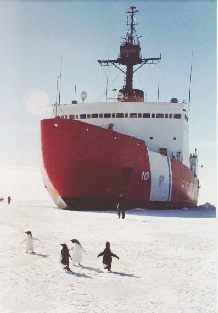
We all got a chance to ride out on the
Polar Star and do a bit of ice breaking . This shot is taken from
the top deck and shows you how the boat deals with the ice.
I just had to put penguin photo in. The ice
breaker has decided to stop in the ice (for whatever reason) and
people are just walking around the base of it. The Adalie
penguins are taking advantage of the tourist attraction, and two
are going to have a better look while the other two have already
seen it and are going home to tell their mates.
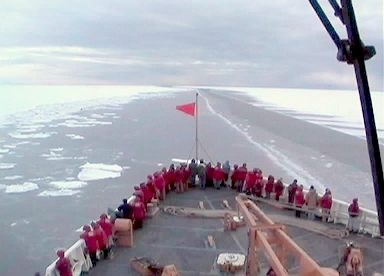 This is a picture of us tourists taking advantage of the trip
out to the ice edge and back on the ice breaker, The Polar Star. The people
in the red coats are Americans; blue coats are New Zealanders. As you can see,
we are slightly outnumbered.
This is a picture of us tourists taking advantage of the trip
out to the ice edge and back on the ice breaker, The Polar Star. The people
in the red coats are Americans; blue coats are New Zealanders. As you can see,
we are slightly outnumbered.
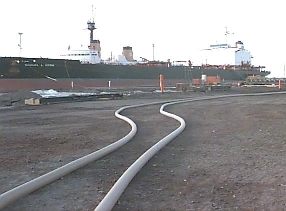 This is the fuel tanker
that comes in and delivers all the fuel we require for the next two years. The
fuel supplies both the Americans and us Kiwis. We buy it off the Americans and
then transport it around to our large fuel tanks once a month. The ship is unloaded
with large flexible fuel hoses. It carries JP8 which we use in all the large
equipment, airplanes, vehicles and helicopters. Kerosene is used instead of
diesel because diesel turns waxy in low temperatures. The ship also supplies
all the Mogas (New Zealanders call it petrol) for all the light equipment and
vehicles.
This is the fuel tanker
that comes in and delivers all the fuel we require for the next two years. The
fuel supplies both the Americans and us Kiwis. We buy it off the Americans and
then transport it around to our large fuel tanks once a month. The ship is unloaded
with large flexible fuel hoses. It carries JP8 which we use in all the large
equipment, airplanes, vehicles and helicopters. Kerosene is used instead of
diesel because diesel turns waxy in low temperatures. The ship also supplies
all the Mogas (New Zealanders call it petrol) for all the light equipment and
vehicles.
 This is the Nathaniel B Palmer. It's mission is
as a science vessel. It constantly hops around Antarctica and
does many of the oceanographic sciences and studies that we are
unable to do on shore. I got a chance to have a look around it
and found that it was a very compact ship. It is only an ice
strengthened ship and has to be careful about the situations
it puts itself in. The definition of ice strengthened ship is
that it has, 'maybe,' a slightly thicker steel plating at the
front of the boat and a slightly rounder hull than a normal boat.
A proper ice breaker on the other hand is purpose built for ice
and it has to meet certain criteria of rounded hull shape, hull
steel plate thickness, maybe even a double skin hull. The
term 'Ice Strengthened' is a bit 'hit and miss' when it defines
the actual capabilities of a ship. Anything less than
an a true ice breaker is unreliable in an ice floe area.
This is the Nathaniel B Palmer. It's mission is
as a science vessel. It constantly hops around Antarctica and
does many of the oceanographic sciences and studies that we are
unable to do on shore. I got a chance to have a look around it
and found that it was a very compact ship. It is only an ice
strengthened ship and has to be careful about the situations
it puts itself in. The definition of ice strengthened ship is
that it has, 'maybe,' a slightly thicker steel plating at the
front of the boat and a slightly rounder hull than a normal boat.
A proper ice breaker on the other hand is purpose built for ice
and it has to meet certain criteria of rounded hull shape, hull
steel plate thickness, maybe even a double skin hull. The
term 'Ice Strengthened' is a bit 'hit and miss' when it defines
the actual capabilities of a ship. Anything less than
an a true ice breaker is unreliable in an ice floe area.
 The Marko Polo is another
ship that frequents the Antarctic but it didn't come into Scott Base or Mactown
because the ice was to unpredictable and with close to 900 people on board the
Captain didn't want to risk the boat or the crew. As it turned out he made the
correct decision, as the piece of ice he was concerned about did end up blocking
the McMurdo entrance later on in the day.
The Marko Polo is another
ship that frequents the Antarctic but it didn't come into Scott Base or Mactown
because the ice was to unpredictable and with close to 900 people on board the
Captain didn't want to risk the boat or the crew. As it turned out he made the
correct decision, as the piece of ice he was concerned about did end up blocking
the McMurdo entrance later on in the day.

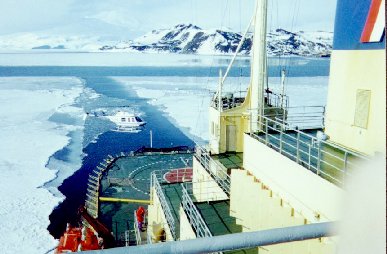

This is the
Kapitan Klebnikov. Or as one of my T shirts says (which I bought
on board when we got a tour around it). AHTAPKTNKA, KAIINTAH
XJIEBHNKOB.
Tourism is starting to become a more
prominent issue in today's economic times, and during the last
part of the summer some of the regular visitors to the Antarctic
visited us once more.
The Kapitan Klembnikov is an old Russian
ice breaker that has been converted to carry tourists. They came
and toured around Scott Base and McMurdo on both its summer
visits to the Antarctic. The Scott Base staff were privileged to
be shown around their ship after showing them around our base. I
had a preconceived idea that it would be an old heap, but when I
arrived on board I was truly impressed by its space, cleanliness
and professionalism - a very nice ship!!. The patrons on board (about
150 of them) were able to get off frequently with the use of two
helicopters, and because it was a true ice breaker ship (not just
ice strengthened like some of the others) it was able to go
safely where other ships couldn't. Most of the patrons on board
were Australian or American.
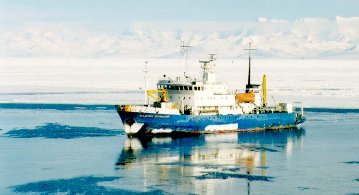 There was also
another ex-Russian ice breaker (turned tourist ship) that came
into the McMurdo Sound, and I think its name was the Academic
Kresnikov. It only carried about 80 passengers and was a bit
smaller in size than the other ships. The people on board seemed
happy enough with the ship and the adventure they where on. The
outside visual condition of the ship meant nothing to the people
living on it. It also toured Scott Base, and we soon became
reasonable tour guides of our home with the people from all the
different ships wanting to know everything about us and the
history of Scott Base and its surroundings.
There was also
another ex-Russian ice breaker (turned tourist ship) that came
into the McMurdo Sound, and I think its name was the Academic
Kresnikov. It only carried about 80 passengers and was a bit
smaller in size than the other ships. The people on board seemed
happy enough with the ship and the adventure they where on. The
outside visual condition of the ship meant nothing to the people
living on it. It also toured Scott Base, and we soon became
reasonable tour guides of our home with the people from all the
different ships wanting to know everything about us and the
history of Scott Base and its surroundings.
www.geocities.com/coolrunnernz/
9-3-01
This page last updated 16
November 1998 Edited by Shirley Baston Fred - [email protected]
- ICQ # 15167279
 This
is a floating ice pier. It is almost impossible to get a normally
constructed pier to survive the constant crushing ice that occurs
during the winter. The American engineers designed a floating
pier made from ice. Every 5 to 7 years they build a new pier by
going out on the new sea ice during winter and making a small
wall around the area of ice they want to use. Then they gradually
fill this enclosed area with fresh water from the RO plant (reverse
osmosis plant that filters the salt out of sea water ). They
build it layer by layer and put steel reinforcing (like you do
with concrete) in between each layer.
This
is a floating ice pier. It is almost impossible to get a normally
constructed pier to survive the constant crushing ice that occurs
during the winter. The American engineers designed a floating
pier made from ice. Every 5 to 7 years they build a new pier by
going out on the new sea ice during winter and making a small
wall around the area of ice they want to use. Then they gradually
fill this enclosed area with fresh water from the RO plant (reverse
osmosis plant that filters the salt out of sea water ). They
build it layer by layer and put steel reinforcing (like you do
with concrete) in between each layer.  The ice/snow wall around the pier is constantly
built up to keep the water in and as the weight of the ice builds
up it slowly lowers into the water (but never goes below it. The
reason for using fresh water is because fresh water floats on top
of salt water (i.e. it has greater buoyancy) and it also takes a
higher temperature to melt it so that during the summer it doesn't
just melt away as quickly as the sea ice which has a very high
salt content. They make the pier about forty feet deep and then
put soil on top of it, to stop the sun from melting it during the
summer. It also stops it from being too slippery to drive on. The
pier is also held to the shore with large wire ropes, so that it
can rise and fall with the tide. Every year it is inspected by
divers for erosion due to melting and ships rubbing against it.
Often cracks will appear and these are fixed by putting fresh
water into them and letting it freeze. When the pier gets too
damaged to repair, they cut the ropes, and then drag it out to
sea so it can melt away into nothing just like any other iceberg.
The ice/snow wall around the pier is constantly
built up to keep the water in and as the weight of the ice builds
up it slowly lowers into the water (but never goes below it. The
reason for using fresh water is because fresh water floats on top
of salt water (i.e. it has greater buoyancy) and it also takes a
higher temperature to melt it so that during the summer it doesn't
just melt away as quickly as the sea ice which has a very high
salt content. They make the pier about forty feet deep and then
put soil on top of it, to stop the sun from melting it during the
summer. It also stops it from being too slippery to drive on. The
pier is also held to the shore with large wire ropes, so that it
can rise and fall with the tide. Every year it is inspected by
divers for erosion due to melting and ships rubbing against it.
Often cracks will appear and these are fixed by putting fresh
water into them and letting it freeze. When the pier gets too
damaged to repair, they cut the ropes, and then drag it out to
sea so it can melt away into nothing just like any other iceberg.



 This is a picture of us tourists taking advantage of the trip
out to the ice edge and back on the ice breaker, The Polar Star. The people
in the red coats are Americans; blue coats are New Zealanders. As you can see,
we are slightly outnumbered.
This is a picture of us tourists taking advantage of the trip
out to the ice edge and back on the ice breaker, The Polar Star. The people
in the red coats are Americans; blue coats are New Zealanders. As you can see,
we are slightly outnumbered.  This is the fuel tanker
that comes in and delivers all the fuel we require for the next two years. The
fuel supplies both the Americans and us Kiwis. We buy it off the Americans and
then transport it around to our large fuel tanks once a month. The ship is unloaded
with large flexible fuel hoses. It carries JP8 which we use in all the large
equipment, airplanes, vehicles and helicopters. Kerosene is used instead of
diesel because diesel turns waxy in low temperatures. The ship also supplies
all the Mogas (New Zealanders call it petrol) for all the light equipment and
vehicles.
This is the fuel tanker
that comes in and delivers all the fuel we require for the next two years. The
fuel supplies both the Americans and us Kiwis. We buy it off the Americans and
then transport it around to our large fuel tanks once a month. The ship is unloaded
with large flexible fuel hoses. It carries JP8 which we use in all the large
equipment, airplanes, vehicles and helicopters. Kerosene is used instead of
diesel because diesel turns waxy in low temperatures. The ship also supplies
all the Mogas (New Zealanders call it petrol) for all the light equipment and
vehicles.  This is the Nathaniel B Palmer. It's mission is
as a science vessel. It constantly hops around Antarctica and
does many of the oceanographic sciences and studies that we are
unable to do on shore. I got a chance to have a look around it
and found that it was a very compact ship. It is only an ice
strengthened ship and has to be careful about the situations
it puts itself in. The definition of ice strengthened ship is
that it has, 'maybe,' a slightly thicker steel plating at the
front of the boat and a slightly rounder hull than a normal boat.
A proper ice breaker on the other hand is purpose built for ice
and it has to meet certain criteria of rounded hull shape, hull
steel plate thickness, maybe even a double skin hull. The
term 'Ice Strengthened' is a bit 'hit and miss' when it defines
the actual capabilities of a ship. Anything less than
an a true ice breaker is unreliable in an ice floe area.
This is the Nathaniel B Palmer. It's mission is
as a science vessel. It constantly hops around Antarctica and
does many of the oceanographic sciences and studies that we are
unable to do on shore. I got a chance to have a look around it
and found that it was a very compact ship. It is only an ice
strengthened ship and has to be careful about the situations
it puts itself in. The definition of ice strengthened ship is
that it has, 'maybe,' a slightly thicker steel plating at the
front of the boat and a slightly rounder hull than a normal boat.
A proper ice breaker on the other hand is purpose built for ice
and it has to meet certain criteria of rounded hull shape, hull
steel plate thickness, maybe even a double skin hull. The
term 'Ice Strengthened' is a bit 'hit and miss' when it defines
the actual capabilities of a ship. Anything less than
an a true ice breaker is unreliable in an ice floe area.  The Marko Polo is another
ship that frequents the Antarctic but it didn't come into Scott Base or Mactown
because the ice was to unpredictable and with close to 900 people on board the
Captain didn't want to risk the boat or the crew. As it turned out he made the
correct decision, as the piece of ice he was concerned about did end up blocking
the McMurdo entrance later on in the day.
The Marko Polo is another
ship that frequents the Antarctic but it didn't come into Scott Base or Mactown
because the ice was to unpredictable and with close to 900 people on board the
Captain didn't want to risk the boat or the crew. As it turned out he made the
correct decision, as the piece of ice he was concerned about did end up blocking
the McMurdo entrance later on in the day. 


 There was also
another ex-Russian ice breaker (turned tourist ship) that came
into the McMurdo Sound, and I think its name was the Academic
Kresnikov. It only carried about 80 passengers and was a bit
smaller in size than the other ships. The people on board seemed
happy enough with the ship and the adventure they where on. The
outside visual condition of the ship meant nothing to the people
living on it. It also toured Scott Base, and we soon became
reasonable tour guides of our home with the people from all the
different ships wanting to know everything about us and the
history of Scott Base and its surroundings.
There was also
another ex-Russian ice breaker (turned tourist ship) that came
into the McMurdo Sound, and I think its name was the Academic
Kresnikov. It only carried about 80 passengers and was a bit
smaller in size than the other ships. The people on board seemed
happy enough with the ship and the adventure they where on. The
outside visual condition of the ship meant nothing to the people
living on it. It also toured Scott Base, and we soon became
reasonable tour guides of our home with the people from all the
different ships wanting to know everything about us and the
history of Scott Base and its surroundings.